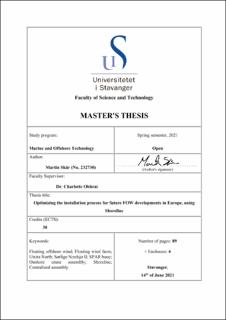| dc.description.abstract | The increasing interest and demand for renewable energy in Europe have supported trials and developments of floating offshore wind turbines in deep waters. It is already well established that about 80% of Europe's potential wind resources are located in waters deeper than 60 meters, but significant investments and improvements in the infrastructure and supply chain will have to be realized to meet the projected installed capacity of floating offshore wind[1]. This paper aims to determine how the increased interest and demands within FOW can be met by changing the assembly and installation procedures. Current planned developments lack efficiency by relying on too many locations during the construction and installation phase; this report explicitly investigates the effects of transitioning to a single multipurpose onshore site that can optimize these processes.
The research question asks how the construction phase of FOW can be optimized, and by doing so, securing Norway a leading role in Europe's floating wind industry. To answer this question, the Shoreline simulation tool was utilized to compare the installation of planned future floating wind projects with the new methods and locations proposed in this study. This was included in a comprehensive case study. Based on the literature study performed in this thesis, it was decided that a location study was required to find a suitable location for an installation hub that could serve Utsira North, Sørlige Nordsjø II, and many future developments.
The simulation results showed that by adapting to a more centralized installation hub, there was a potential of reducing the project duration by 52% on average. This confirmed the hypothesis stating that the downtime and installation process will drastically improve if the assembly and installation process is centralized and moved entirely onshore. Other results demonstrated that the seasonal change in weather has dramatic effects on the overall project duration of smaller floating wind developments, an effect that proved to be less significant for more extensive and more realistic projects. These results suggest that targeted investments in infrastructure specific for the installation of floating offshore wind can have a considerable effect on the installation time and cost of floating wind developments. By taking advantage of the knowledge and experience gained from floating structures in the offshore oil and gas industry while utilizing the industrialization on onshore steel tower sections, the results indicate that a transition to this model could advance Norway into a leading role in the FOW market. | |
